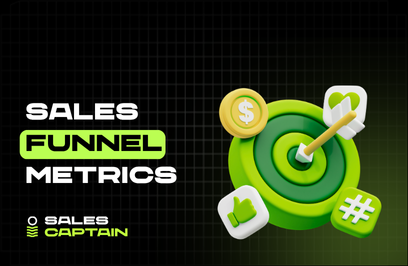

How to Use AI in Sales: Tools, Strategies, and Real-World Impact

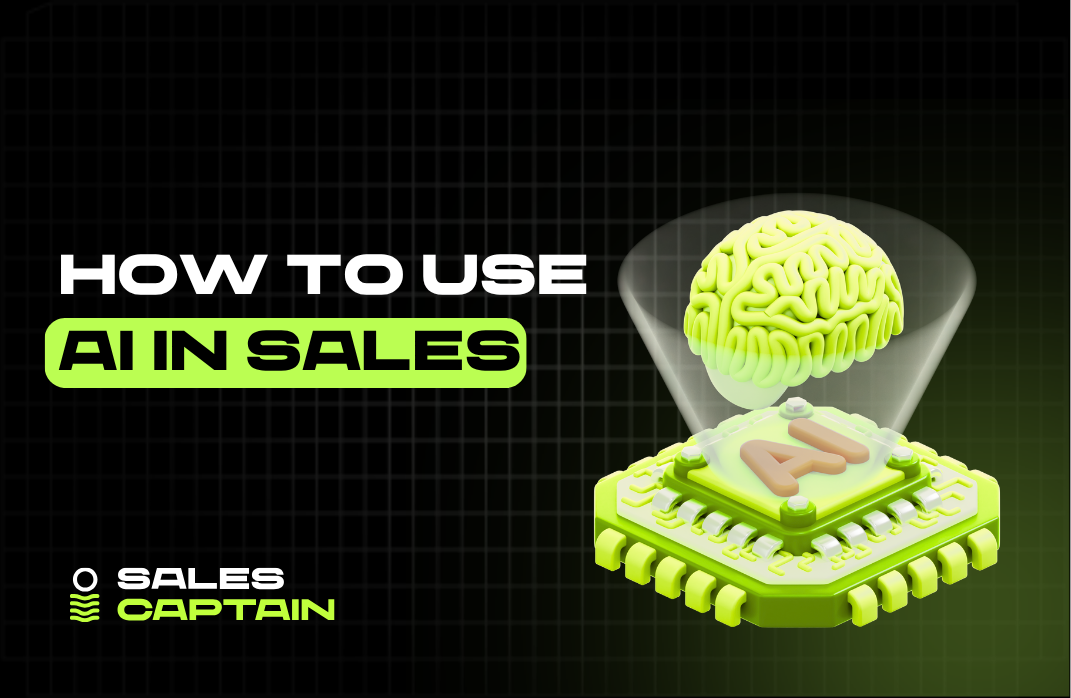
Introduction to AI in Sales
What is Artificial Intelligence in a Sales Context?
Artificial Intelligence in sales isn't just hype or some black-box math experiment. It's software that can learn patterns, make decisions, and execute tasks that usually require human effort. Think algorithms trained on behavior, language models fine-tuned on sales conversations, and tools that analyze millions of data points to surface what really moves a deal forward.
In a sales context, AI has one job: do more of what works, less of what doesn’t, and free up humans to focus on higher-impact activities. It plugs into workflows like outbound prospecting, lead scoring, deal forecasting, CRM management, and sales coaching. It doesn't replace sellers, it makes them faster, sharper, and more informed.
Why AI is Transforming Modern Sales Teams
Sales used to be relationship-driven and gut-based. Now it’s a data operation. The teams winning today are running scalable outbound plays, using predictive insights, and building GTM systems that learn and adapt in real time. AI turns manual, linear processes into orchestrated, signal-driven motions.
AI is transforming sales the same way automation transformed manufacturing. Reps don’t need to write every outreach from scratch or spend hours logging CRM updates. SDRs don’t need to manually sift through databases. Instead, teams are hiring RevOps and technical operators to architect workflows powered by AI.
Outbound is now a marketing channel, fueled by targeted messaging, real-time buyer signals, and scalable personalization. AI makes this possible without bloating headcount.
Key Benefits of Leveraging AI in Sales
- Speed to lead: No human SDR can respond in 8 seconds. AI can.
- Scalability: One operator can run outreach campaigns across 10 verticals at once.
- Consistency: Messaging, timing, follow-ups, AI doesn’t forget or get lazy.
- Data-driven decisions: Forecasting and deal reviews are based on actual behavior, not opinions.
- Rep efficiency: Salespeople spend more time in conversations, less time on admin.
Bottom line: AI helps sales teams do more, in less time, with better outcomes. And that’s the bar now, not the bonus.
Core Applications of AI in the Sales Process
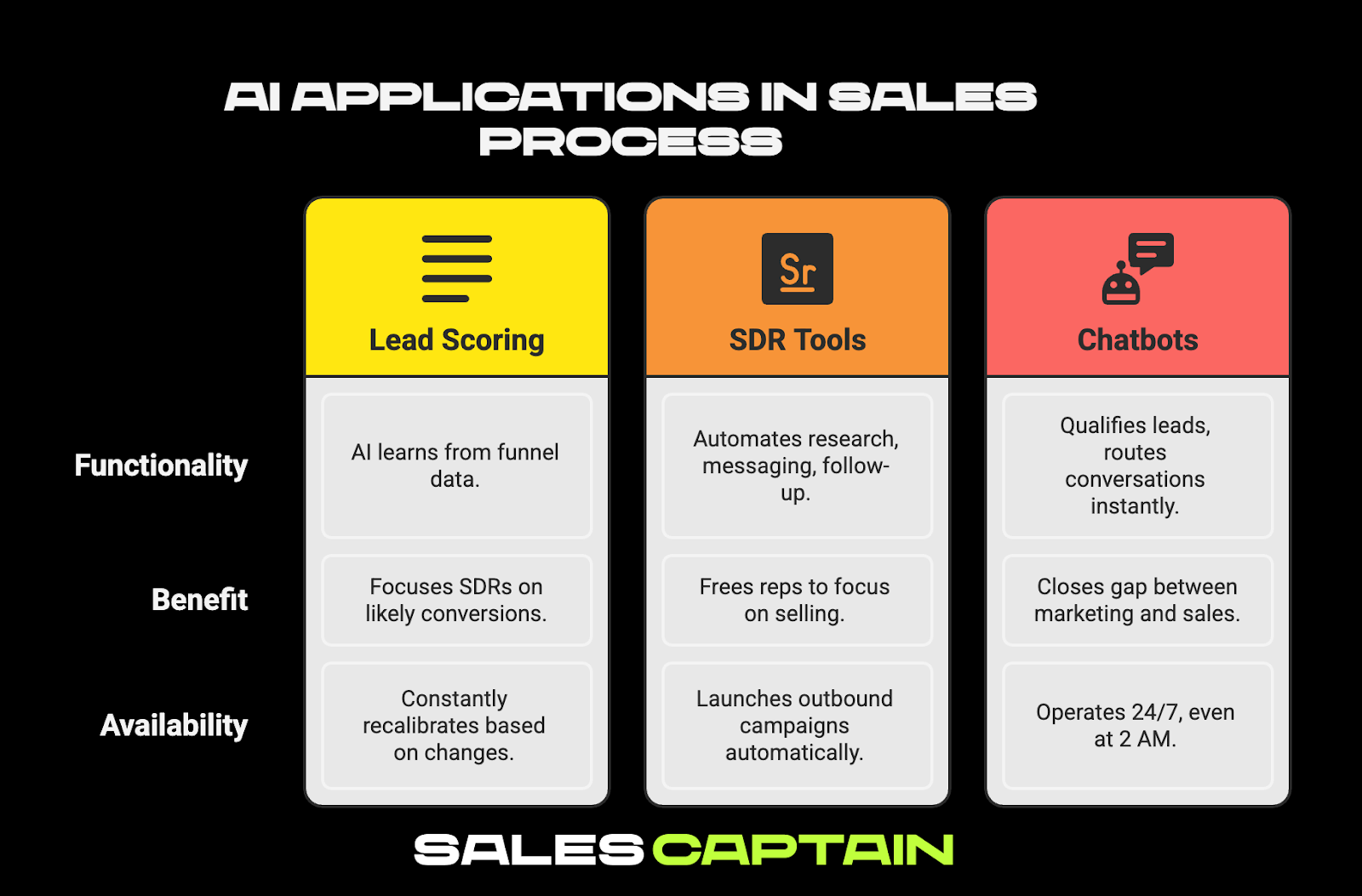
Lead Generation and Qualification
AI-Powered Lead Scoring
Manual lead scoring rules are outdated before you finish writing them. AI-based scoring learns directly from your funnel: what types of leads move to meetings, which ones close, and which ones waste time. It constantly recalibrates based on pipeline changes and actual sales outcomes.
This means SDRs aren’t chasing random MQLs. They’re focused on prospects most likely to convert, informed by real behavioral signals, not form fills alone.
Autonomous SDR Tools and AI Assistants
Software is replacing large chunks of SDR tasks. AI assistants can research leads, craft personalized messages, follow up relentlessly, and book meetings. An operator can now launch entire outbound campaigns without ever writing an email manually.
Think reps focused on selling, not copying LinkedIn job titles into Outreach. The SDR is evolving, not into a role, but into a workflow layer powered by AI.
24/7 Qualification via Chatbots
AI-driven chatbots do more than just greet visitors. They qualify leads, ask intelligent questions, and route high-intent conversations to reps instantly, even at 2 AM. Triggers can be set based on time-on-page, industry, and company fit.
This closes the gap between marketing engagement and sales follow-up, without needing more headcount.
Sales Prospecting Automation
Conversational AI for Initial Outreach
Large Language Models (LLMs) are changing the game for first-touch outreach. These tools generate human-like emails, first lines, and even full threads, tailored to each persona, all in seconds.
It’s not just about saving time writing. It’s about framing outreach with relevance at scale.
Predictive Targeting and Email Personalization
AI can analyze who actually responds, converts, and books meetings, then use that data to shape future campaigns. This enables list building and email personalization that’s signal-driven, not static.
If you’re not using AI to decide who to email and what to say, you’ll lose to someone who is.
Customer Relationship Management (CRM) Optimization
AI-Based Data Entry and Enrichment
No more reps forgetting to log a call or update a contact. AI can auto-populate CRM fields, enrich contact data from public sources, and sync conversations back into the system.
Clean data becomes table stakes once AI is in play, because every insight downstream depends on it.
Smart Account Segmentation and Insights
AI helps surface patterns in customer behavior, firmographics, and past actions. This turns your CRM into an intelligence layer, surfacing high-propensity accounts, cross-sell opportunities, or at-risk deals before they slip.
It’s like running SQL queries on your revenue, without needing an analyst.
Sales Engagement and Communication
Email Personalization and Chat Recommendations
Machine learning can now personalize emails with more than [{{first.name}} and {{company.name}}]. AI tools pull context from websites, job descriptions, funding activity, and more, all in real time.
Live chat tools also use AI to suggest smart responses, routes, and offers based on customer interaction patterns.
AI-Supported Follow-Up Cadences
Following up used to be an art. Now it’s a data-informed science. AI helps optimize when to follow up, what message to send, and which leads are worth pursuing longer.
Cadences adjust dynamically based on past engagement, not guesswork.
Natural Language Generation (NLG) for Sales Pitches
AI can generate proposals, elevator pitches, and even product explanations tailored to different verticals or buyer personas. It's not perfect on the first try, but it gives reps a serious head start.
Less staring at blank pages, more selling.
Sales Content Creation and Enablement
Content Suggestions Based on Buyer Intent
AI identifies which case studies, product sheets, or videos actually move deals forward based on CRM and engagement data. Then it surfaces that content in real time, based on where the buyer is in the journey.
Sales enablement becomes real-time and buyer-triggered, not static PDFs in Google Drive.
Generative AI for Sales Decks and Proposals
Reps can use AI to auto-generate sales decks, proposals, and ROI calculators using deal data, persona info, and past templates. Teams move faster, stay consistent, and keep messaging sharp.
Script Refinement Using Conversation Data
AI tools can analyze thousands of sales calls to suggest better talk tracks, objection handling responses, and messaging angles, based on what actually increases win rates. Less guessing. More evidence-led messaging.
Forecasting and Pipeline Management
Predictive Analytics for Deal Success Probability
AI models don’t just track how much is in the pipeline, they signal what’s real and what’s noise. Based on historical patterns, rep activity, email intent signals, and deal velocity, AI can estimate the probability of closing far more accurately than a gut check.
Pipeline Health Monitoring with AI
Instead of digging through deals manually, AI surfaces red flags like stalled ops, unresponsive champions, or competitive threats. Leaders see which segments, reps, or sources are driving real pipeline, without waiting on reports.
Automated Forecast Adjustments Based on Insights
When close dates shift, or deal size changes, AI can automatically adjust forecasts to reflect reality. No more end-of-quarter surprises. Sales leaders get a dynamic, trustworthy view of where things stand.
Competitive and Market Intelligence
AI for Monitoring Competitor Activity
AI can track changes on competitor websites, LinkedIn updates, pricing pages, hiring trends, funding activity, and alert your team in real time. This turns passive monitoring into actionable intelligence.
Trend Identification and Sentiment Analysis
AI scans public content, social sentiment, buyer reviews, and market signals to identify emerging pain points or buyer behavior shifts. Sellers don’t just respond to trends, they get ahead of them.
Sales Coaching and Performance Optimization
AI-Powered Conversation Intelligence Tools
Platforms can analyze sales calls for talk ratio, filler words, objection handling, and competitor mentions. Sales managers get more than gut feeling, they get data-backed insight into coachable moments.
Post-Call Summarization and Action Recommendations
AI can auto-summarize sales calls, highlight objections, suggest next steps, and draft recap emails. Sellers stay focused on relationships, not admin. Managers get context without listening to ten hours of calls.
Roleplay Simulators and Coaching Feedback
AI-driven simulators can recreate selling situations, and give real feedback. Reps practice objection handling, demo flow, or messaging consistency in a low-risk environment. Great for onboarding, even better for leveling up veterans.
Cross-sell and Upsell Recommendations
Pattern Recognition in Buying Behavior
AI identifies which usage patterns, personas, or product combinations signal readiness for upsell. This gives reps a precise playbook, not just “check in and see how things are going.”
Personalized Product Suggestions
Using customer data and past behavior, AI can recommend specific features, packages, or add-ons that are most likely to resonate. It’s like Amazon “recommended products,” but for enterprise software deals.
Results and ROI from AI Adoption in Sales
Increased Productivity
When routine tasks are automated, reps spend more time in conversations and less in CRMs. AI clears the clutter. Admin, data entry, prospect research, it’s all absorbable by models and tools. Instead of 60% of time spiraling into non-selling activities, reps get hours back per week. For operators, this means scalable systems with smaller teams. One RevOps generalist can now power workflows that used to require five SDRs.
Higher Win and Conversion Rates
AI doesn’t just move faster, it moves smarter. With predictive models flagging high-intent leads, hyper-personalized messaging tools feeding the top of funnel, and insights that coach reps in real time, the compound effect is clear: higher close rates. Email open rates tick up when messaging is actually relevant. Meeting booked rates spike when outreach timing aligns with buyer signals. The result? Fewer leads wasted. More deals moved forward.
Better Customer Engagement
AI tracks how buyers engage across every touchpoint, not just clicks, but tone, timing, and behavioral patterns. This data gets used instantly to shape smarter outreach and more relevant follow-ups. Your sales team becomes responsive, not reactive. Personalized chatbots guide visitors toward value. Smart sequencers adjust cadences based on real engagement, not just templates. Done right, buyers feel heard before a human even joins the conversation.
Enhanced Decision Making
Forecasters don’t have to guess. Managers don’t need to dig through individual deals to spot risk. AI surfaces reality, who’s at risk, what’ll close, and who’s sandbagging. Decisions move from intuition to evidence. From “what’s your commit?” to “here’s what the signals say.” And it’s not just leadership. AI helps reps self-correct, with feedback loops from every call, every click, every win.
AI in Sales: Challenges and Considerations
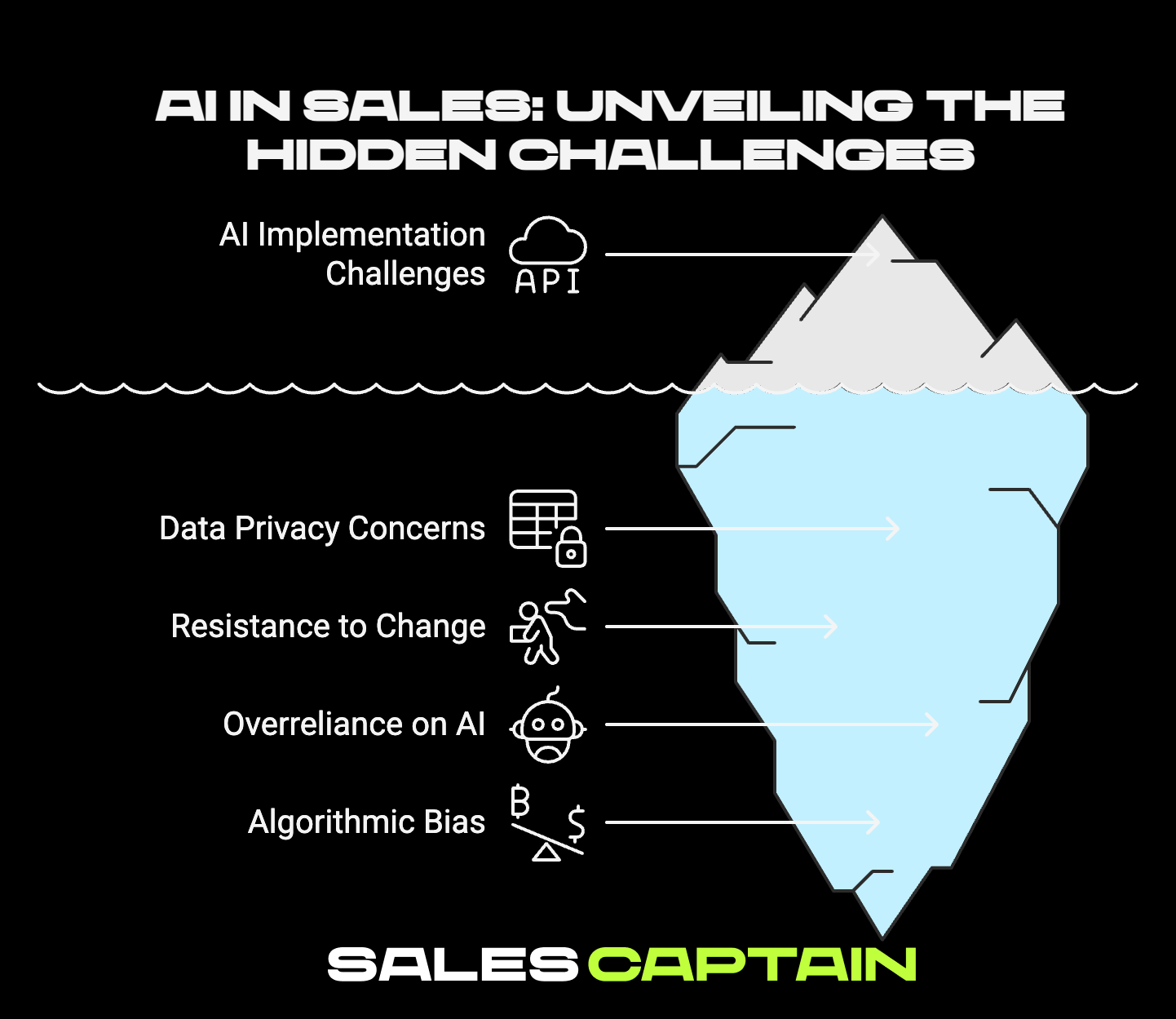
Data Privacy and Security Concerns
Sales tech often means pushing data into dozens of tools. Contact info, conversation transcripts, buyer activity, it adds up fast. And AI tools need that data to train and perform. But that also means greater responsibility. GDPR, CCPA, and enterprise compliance rules don’t flex just because your chatbot’s smart. Every AI workflow needs governance: Who owns the data? Who can see what? Where is it stored?
Resistance to Change within Sales Teams
For many reps, AI feels like surveillance. Or like a threat. Adoption stalls not because tools aren’t good, but because reps don’t trust them. Or don’t know how to use them. Or think they’re being replaced. It’s a leadership challenge, not a technical one. Rollout fails when it’s a tool dumped into the workflow. It works when it’s a system designed around how people already work, just faster, sharper, and more helpful.
Overreliance and Lack of Human Judgment
AI can write the perfect sequence. But it can’t read the room. Or handle nuance when a stakeholder ghosts the deal. High-performing teams use AI like jet fuel, not autopilot. Overreliance leads to robotic cadences, generic decks, and clunky demos. Judgment still matters. Relationship context still wins deals. AI is the muscle, not the brain.
Avoiding Bias in AI Algorithms
AI models learn from data, and that data often reflects bias. Which personas get prioritized? Who gets recommended for outreach? What objections are flagged as “weak”? If your training data is skewed, your outcomes will be too. Sales teams need to monitor and audit AI-driven recommendations to ensure they support fairness, accuracy, and diversity, especially when models impact who gets heard and who doesn’t.
The Future of Selling with AI
Evolving Buyer Expectations and AI’s Role
Buyers don’t want another generic demo invite. They want relevance. Speed. Competence. AI helps bridge those expectations, by tracking buyer signals, preempting questions, and tailoring interactions across every touchpoint. As B2B buying becomes more self-directed and time-constrained, sellers need to show up with insight, not just availability. AI will quietly drive that shift, powering outreach before interest is declared, nudging next steps before deals stall.
Next-Gen Autonomous Selling Agents
We’re moving toward touchless selling motions, where AI agents can run a prospect from cold touch to meeting without human input. Not science fiction. It’s already being built. These agents research the lead, craft messaging, run multi-threaded follow-ups, and book meetings. Humans step in to close, not chase. Technical operators now build these workflows instead of hiring more headcount.
AI-powered Revenue Optimization
Revenue isn’t just about closing deals. It’s about pricing, expansion, churn, and margin, all variables AI can now optimize in real time. Expect AI to play a bigger role in recommending discount levels, flagging upsell timing, and even advising on territory planning. What used to require custom analysis and long feedback loops will become dynamic, system-driven inputs for operators and GTM leaders.
Ethical AI Use in Sales
AI can scale good systems, or bad ones. Ethics matters. Are buyers being manipulated by behavioral scoring that pressures decisions? Are underrepresented groups being targeted unfairly based on model training data? Are consent and transparency broken in the name of personalization? As AI becomes embedded in every sales motion, the teams who win long-term will be the ones who treat ethics like infrastructure, not afterthought.
Sales AI Best Practices
Customize AI Tools for Your Sales Workflow
Too many teams buy tools off the shelf, then wonder why adoption fails. AI needs to fit into your system, your ICP, your messaging, your stages, your tech stack. Tooling should be modular, programmable, and aligned with how your team already works. Operators, not just end users, need control. AI is most powerful when it’s not another tab, but part of the way you sell.
Test, Measure, and Iterate Your AI Strategy
AI isn’t a switch to flip. It’s a system to tune. Start with one part of the funnel, outbound, enrichment, call review, and track the impact. What moved? What broke? What needs tuning? Build feedback loops so insights feed usage. Treat AI like CRO, continuous optimization, not one-and-done implementation.
Combine AI Insights with Human Intuition
AI spots patterns, not context. It’ll tell you which accounts are heating up but not why the champion suddenly went cold. Pair machine-surfaced data with rep instinct and real conversation insight. That’s how teams build signal-driven but relationship-centric playbooks. The right balance isn’t AI vs humans, it’s humans with smarter tools.
Set Clear Goals and KPIs for AI Initiatives
“Using AI” isn’t a success metric. What problem are you solving? Faster response times? Higher conversion rates? Shorter deal cycles? Set clear KPIs tied to business outcomes, not just tool usage. Define what success looks like before you deploy. Then instrument your pipeline to actually measure it.
FAQs
Don’t try to automate everything at once. Start with one high-leverage area, outbound personalization, lead scoring, or call review, and prove value. Look for tools that integrate easily with your current stack. Assign a technical operator to own AI workflows, not just a rep to “try it out.” Build it into the system, not as a side experiment.
Generative AI creates content, emails, pitches, collateral, based on context. Predictive AI forecasts outcomes or recommends actions, which leads to pursue, which deals are at risk, which reps need coaching. Both are useful, but solve different problems. One fuels creativity, the other drives decisions.
No. AI handles process, not people. It automates outreach, analyzes calls, recommends content, but it can’t build relationships, navigate politics, or close complex deals. The future isn’t rep-less. It’s rep-augmented. AI removes the low-leverage work so humans can focus on what actually wins.
Yes. B2B tools focus more on account-based data, complex buyer journeys, and multi-threaded interactions. B2C tools lean toward high-volume, fast-cycle selling. Some AI platforms serve both, but B2B-specific tools (like Clay for outbound orchestration) are built for longer cycles, richer signals, and multi-channel orchestration.
Tools like Clay (for outbound automation and signal-based prospecting), Gong (for conversation intelligence), Apollo and Lavender (for email personalization), and People.ai (for revenue intelligence) are common across modern stacks. The key isn’t which tool, it’s how well it plugs into your GTM system.
Tie usage to direct outcomes. If you automate outbound, measure if meeting volume goes up at the same headcount. If you run AI call coaching, measure win rates and deal velocity. ROI isn’t soft, it's pipeline per rep, speed per deal, close rates, and time to onboard new hires. Quantify what the AI replaced or enhanced.
Reps need to become system operators, not keyboard warriors. Skills like prompt writing, tool configuration, and understanding AI outputs will matter. But so will the soft stuff, navigating nuance, adapting messaging, and building trust. The best reps will blend technical dexterity with emotional intelligence.
It can be, if deployed intentionally. Look for vendors with clear GDPR/CCPA compliance, strong encryption, and user-level permissioning. Don’t just trust the feature list. Ask where data is stored, how models are trained, and how audit logs work. If privacy isn’t part of your AI implementation plan, you’re exposed.
RELATED ARTICLES
Lorem ipsum dolor sit amet, consectetuer adipiscing elit, sed diam nonummy nibh euismod tincidunt ut laoreet dolore magna aliquam erat volutpat.
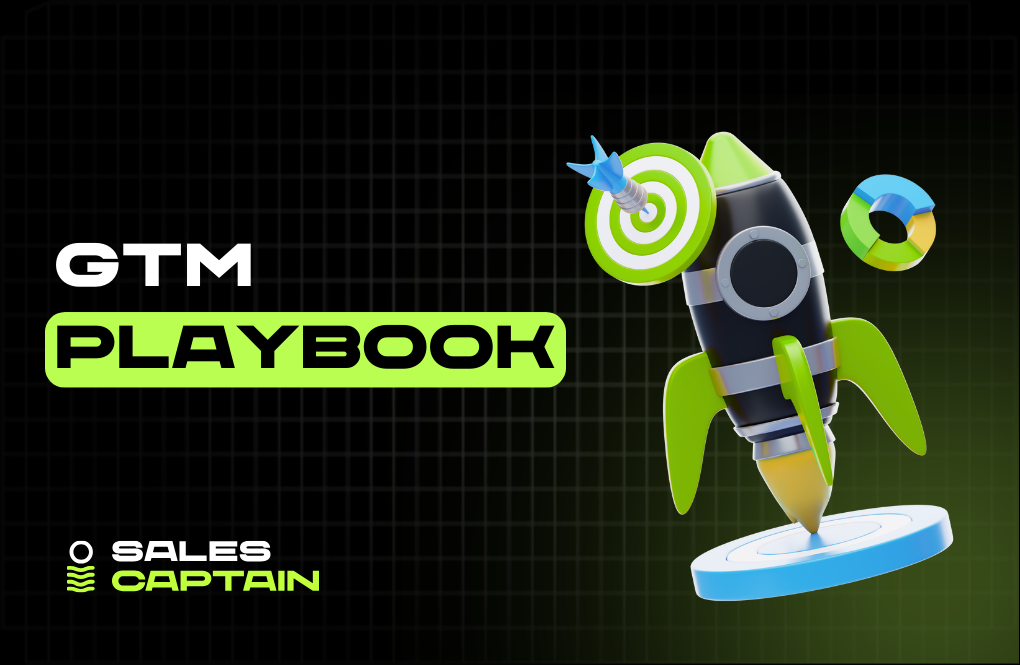



.jpg)
